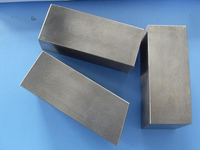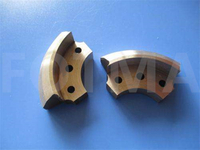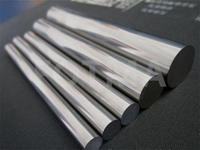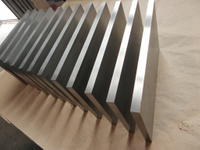Views: 13 Author: Site Editor Publish Time: 2018-04-10 Origin: Site
Superalloys are widely used in aviation, aerospace, warships, power generation, power, locomotives, and petroleum and chemical industries as key components of materials due to their unique mechanical and physical properties. Tungsten-containing superalloys are mainly used in service environments where the service temperature is high. For example, GH4037 alloys (W mass fraction of 5.0% to 7.0%) can be used below 850°C; GH4049 alloys (W mass fraction of 5.0% to 7.0) %) can still have fairly high strength at temperatures up to 950°C; GH4098 alloy (W mass fraction 5.5% to 7.0%) long-term working temperature up to 1000°C; GH5188 alloy W mass fraction 14% Increases the maximum operating temperature to 1100°C. Tungsten-containing superalloys are commonly used to make turbine blades and other high-temperature load-bearing parts in jet engines.
Since tungsten is harder to melt, tungsten inclusions tend to occur in tungsten-containing high-temperature alloys. If there are tungsten inclusions in the blades and other parts, the inclusions will cause stress concentration and become fatigue sources under alternating loads, which will seriously affect the reliability of the aero-engine turbine blades, hoop segments and ferrules. Therefore, the researchers conducted a detailed analysis of the reasons for the formation of tungsten inclusions in tungsten-containing high-temperature alloy bars, in order to provide theoretical guidance and basis for improving the production quality of high-temperature alloys.
The study found that the morphology of tungsten inclusions in GH4049 alloy is extremely irregular, and there is a crack-like gap with the matrix, and there are black dots inside the inclusion. Further energy spectrum analysis shows that the main component of the inclusions is tungsten and a small amount of lanthanum, and the main component of black spots is lanthanum.
There are two sources of tungsten inclusions in high-temperature alloys: one is that the tungsten strip is not completely melted in the vacuum induction furnace and remains in the alloy, and the second is that the tungsten electrode used in the argon arc welding of the electrode rods is bonded to the weld.
When vacuum induction smelts a high-temperature alloy containing tungsten, the high-melting tungsten may not completely melt, resulting in the formation of tungsten inclusions. In order to prevent the formation of tungsten inclusions, when vacuum induction melting of a high-temperature alloy containing tungsten is higher, the tungsten used for smelting is added in the form of a Ni-W master alloy, and a sufficient melting time is selected, and tungsten inclusion is not generated during smelting.
The smelting of high-temperature alloy adopts vacuum induction melting and electroslag remelting process. If the electrode rods are long-handedly welded, the welding seams of the electrode rods will easily adhere to the tungsten poles, resulting in inclusions. Over the years, domestic methods for the welding of high temperature alloy electrode rods include tungsten arc welding and plasma arc welding. Research indicates:
(1) The tungsten electrode used for argon-arc welding is outside the nozzle of the welding torch. Inadvertent operation will cause the melted tungsten electrode to adhere to the weld seam; in addition, the argon-filled nozzle will have tungsten deposits on the inner wall of the ceramic tube. "The increase in argon flow may blow the "reservoir" down to the weld, thus forming tungsten inclusions.
(2) Unreasonable plasma arc welding guns result in plasma arc welding equipment not forming a true plasma arc and the heating capacity is reduced. If a large current is used, tungsten is prone to melting, and the greater the current, the more likely it is to melt. Larger, high-temperature alloy electrodes have a higher probability of tungsten inclusion during welding.
(3) The use of a plasma arc welding machine with a reasonable structure of the welding torch can solve the problem of tungsten inclusion in high-temperature alloys.





